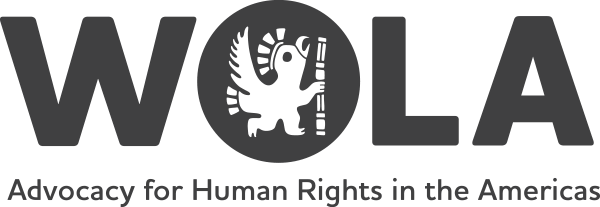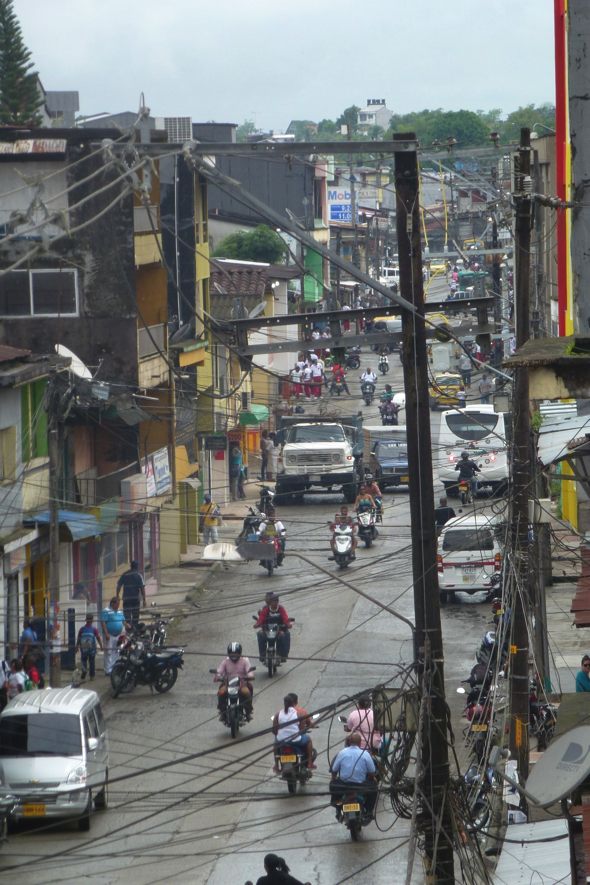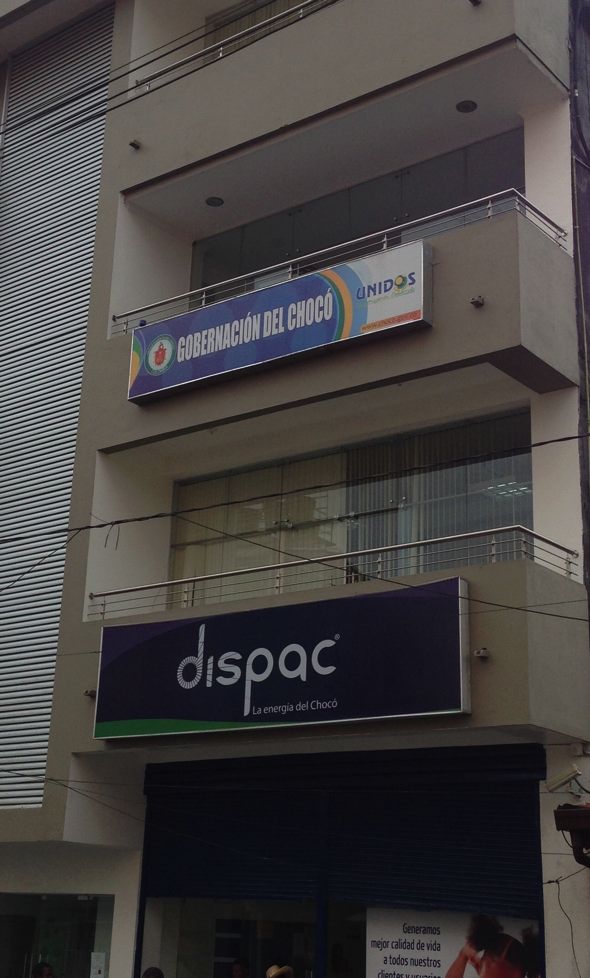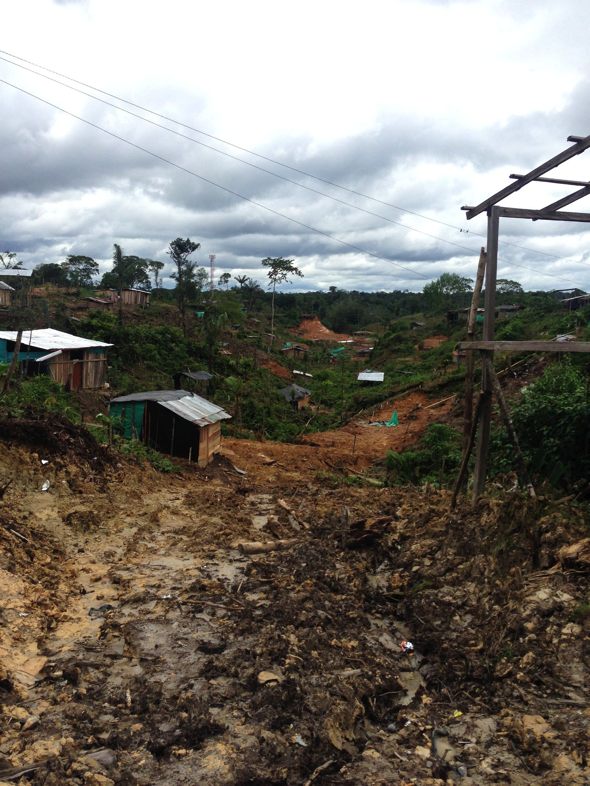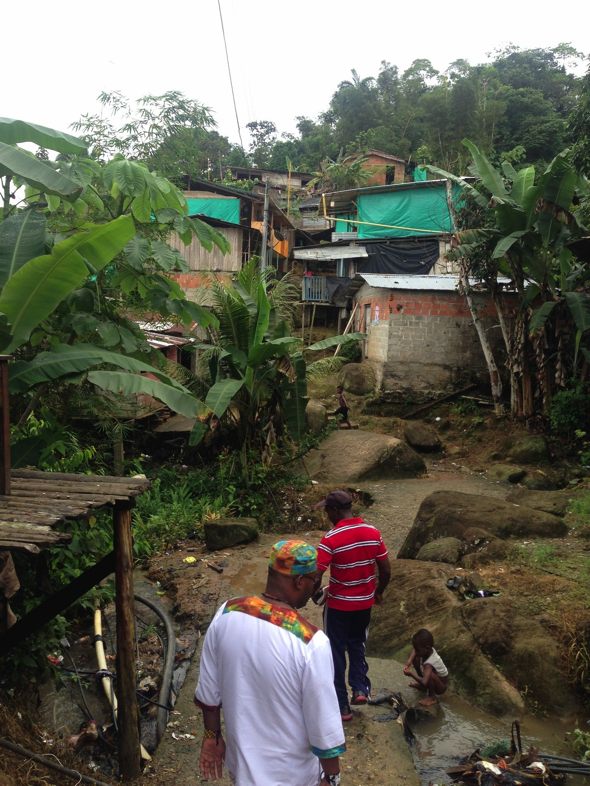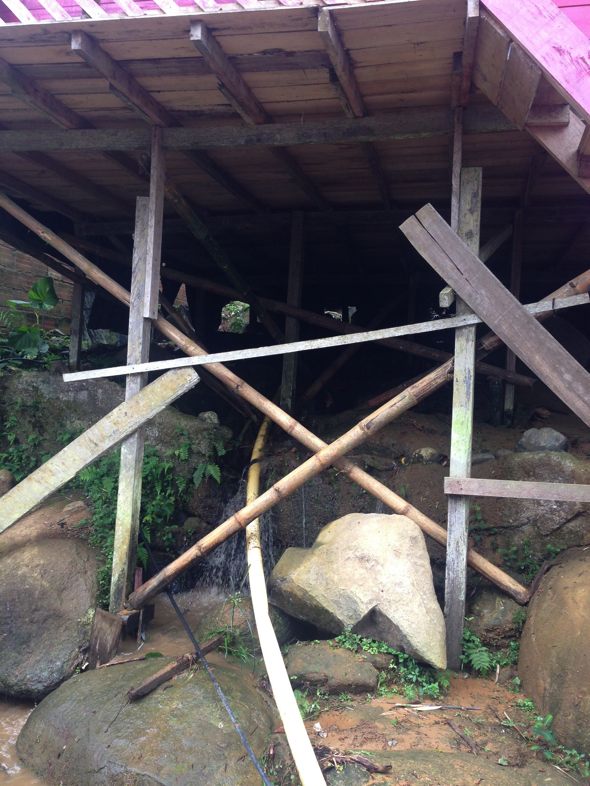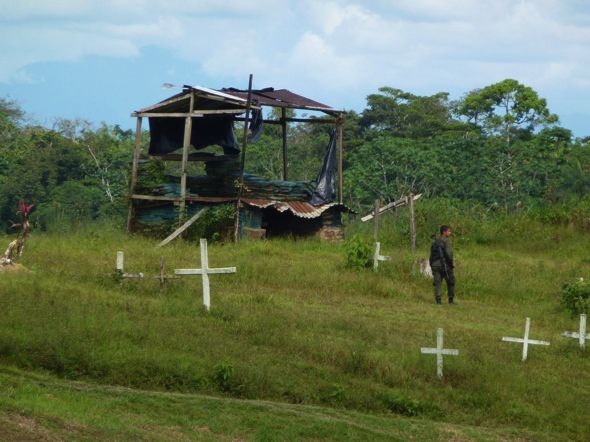Adam Isacson’s posts about conflict, displacement, illegal mining, U.S. policy – and the region’s vibrant civil society
Adam Isacson, WOLA’s Senior Associate for Regional Security Policy, joined Senior Associate Gimena Sánchez-Garzoli and Program Assistant Adam Schaffer on a six-day visit to the department of Chocó, in northwestern Colombia, in March 2014. While traveling, Adam posted several observations and photos to his personal Tumblr site. These are reproduced below.
It feels like I’ve just returned from my Mexico-Guatemala border trip, but it’s time for more travel.
I’m flying to Colombia tomorrow, where together with Gimena and Adam S. from WOLA, I’ll be spending 6 days in the department (province) of Chocó, in the country’s northwest. I’ve never been to Chocó before.
It’s Colombia’s poorest department, with large indigenous and afro-Colombian populations. It has a significant presence of armed groups and, with those long coastlines, is used by narcotraffickers. The security and human rights situations are very serious. In 2012, meanwhile, Chocó was the 2nd most-sprayed department under the U.S. funded anti-drug aerial herbicide fumigation program.
After Chocó, I’ll be spending two days in Bogotá before heading back home. I’ll post from the road, as time and bandwidth allow.
Posted March 21, 2014
Quibdó, Chocó, Colombia. Friendly police here. (From Instagram.)
Posted March 22, 2014
To Find the State Capitol, Look Up
I took this shot of downtown Quibdó, Colombia this morning, from the terrace of the governor’s office—the center of government for Chocó department (province) in northwestern Colombia. Chocó borders Panama, and is the only province or state in the world with coasts on both the Atlantic and Pacific oceans.
The governor’s office occupies the second floor of a nondescript office building, and when you’re on the street, you have to look up to notice the sign. It could be a discount law office or something.
There used to be a proper government building, but a “remodeling” project stalled after several years of intense corruption. So the “Capitol” of a department larger than several U.S. states is an office suite not much bigger (if at all) than WOLA’s.
Posted March 23, 2014
Living In a “Land Invasion”
This is how people connect their homes to electricity in Curvacabí, a recent “land invasion” on the southern outskirts of Quibdó, capital of the department of Chocó in northwest Colombia.
The term refers to what happens when people—in Colombia, usually forcibly displaced people—move into an unused patch of land that belongs to someone else, with the intention of living there. They bring in building materials and start building their own houses.
In Curvacabí, the “invaders” are about 200 families, nearly all of them Afro-Colombian and indigenous people from elsewhere in Chocó, many driven out by violence. People with very different cultural customs, dress, even language, living side by side. Clearing their patches of land, putting up roofs then walls, and collaborating on maintenance of access roads and creating pirate connections to the electrical grid. (Curvacabí lies behind a hill alongside the main road leading south out of Quibdó, so the power lines are located nearby.)
It’s a strange place to visit. Some of the more established (that is, months-old) buildings have wooden walls and new corrugated-metal roofs. There was a reasonably well-stocked grocery where we drank cold sodas and talked to the proprietor and customers. There was even a basic bar with a pair of pool tables.
A hundred yards down the dirt street that residents had cleared, the construction is newer. Clear to the next hillside one sees dozens of houses (shelters, really) in various stages of completion, many without walls yet. Some plots are just flat earth where a house had been until a police eviction ten months ago.
As it turns out, this is not the first invasion of Curvacabí. In early 2013 an individual claiming to be the land’s rightful owner petitioned the municipal government to eject the families. At the end of April, the petition was fulfilled. Wearing their usual “Robocop” armor, members of the Colombian National Police force’s feared Anti-Disturbances Squadron (ESMAD) swept into the site, pushing out the families while chainsaw-wielding demolition workers took down their shacks.
Within about three months, many if not most of the families had returned and started to build again. Another family with claims to the property emerged. This claimant appears to be more benign, promising to deed the land to the families if the municipal government provides some payment and commits to delivering basic services.
The dispute is in some slow stage of resolution—I’m not sure exactly where, as the story is pretty complicated. The community says that the second (benign) party holds clear title, and that the first—the one behind last year’s eviction—has upheld his claim simply by corrupting officials. I have no idea where the truth lies.
In the meantime, though, the families in Curvacabí are building at a feverish pace. During my hour there I saw trucks delivering fresh wood amid a constant sound of hammers and saws.
And also the sound of radios, fed by an electrical connection so precarious that all light bulbs cycled constantly from bright to dim and bright again.
Posted March 23, 2014
Kids playing outside the police station in Bagadó, Chocó, Colombia. (From Instagram)
Posted March 24, 2014
“Zozobra,” the Word in Tagachí
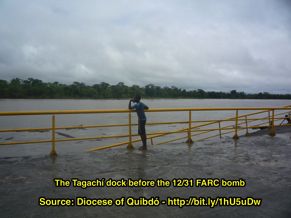 |
 |
 |
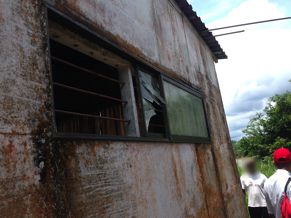 |
On Saturday we traveled a couple of hours downriver (north) from Quibdó to the Medio Atrato region. In this area, an important trafficking corridor, the riverfront fishing communities’ Afro-Colombian and indigenous population has been hit hard by violence since the mid-1990s.
Things are calmer now than during the vicious paramilitary onslaught of the late 1990s and early 2000s, which claimed thousands of lives and displaced tens of thousands. Still, residents with whom we spoke kept using the word zozobra (anguish, anxiety) to describe the current mood in the Medio Atrato.
Tagachí, a riverside village of less than 200 families, is in a fog of zozobra. These photos show damage from a “boat bomb,” loaded with nails and other shrapnel, that the FARC’s 34th Front detonated under the town’s dock on December 30, at a time when a contingent of soldiers was encamped in a nearby community center. Tagachí has no permanent military or police facilities; every several weeks, soldiers or marines pass through for a few days at a time.
The top photo, from the Quibdó Diocese, shows the Tagachí dock before the bomb. I took the bottom photo on Saturday. The broken window in the middle right photo is about a hundred yards from the blast.
No civilians were hurt, as the bomb went off at a time when the dock area was empty. There were military and perhaps guerrilla casualties, though, in the firefight that ensued after the bomb went off.
Note that December 30, the date of the Tagachí attack, is right in the middle of the 30-day period in which the FARC was supposedly observing a unilateral cease-fire (December 15-January 15). This incident does not appear in independent analysts’ lists of cease-fire violations, but numerous sources tell us that the FARC has claimed responsibility.
More than that, in fact. According to several separate accounts, on the evening of January 30, guerrillas arrived in Tagachí and called the community to attend a mandatory meeting. The December 30 bomb was just an ensayo (a test or rehearsal), a guerrilla leader explained. If residents again “allow” the military to be there, he said, the next bomb would be large enough to destroy much of the town. The guerrilla leader also told residents to “pay no mind” to the negotiations happening in Havana, that “here, we’re the ones in charge.”
(Interestingly, Tagachí has a cellphone tower with a decent signal, even data access. “Everybody here has a phone,” residents said. But if anyone dared to call or text the authorities during the January 30 guerrilla meeting, it had no effect. The FARC are conscious of the risk; the guerrilla leader mentioned the future possibility of restricting residents’ mobile phone usage to a few public areas.)
Tagachí looks tranquil and relatively prosperous. Residents complain of state neglect including the lack of even a basic health post, and nondelivery of fuel for electricity. But food is abundant, walkways are paved, and the town boasts a rice processing plant and an adult education center. International donors have helped with productive and cultural projects. People gather outside, and children play everywhere, on a sunny Saturday afternoon.
But after the FARC threat, the townspeople are ready to run at any moment. “If the military comes back, we’ll have to leave,” one resident told us. A religious worker from another town said that one day in the past few weeks, when a boatload of soldiers approached Tagachí, everyone stopped what they were doing and ran to their homes, prepared to flee. It was a false alarm—the soldiers kept going.
Nonetheless, the military could soon be coming to stay. With U.S. advice, Colombia’s Defense Ministry has been carrying out “Sword of Honor,” a campaign plan based on joint military-police task forces operating in specific regions around the country. The idea is to confront and weaken some of the FARC’s strongest fronts. At the beginning of this year, “Joint Task Force Titán,” with about 2,500 members, began operations in Chocó.
As the Task Force works to increase the security forces’ presence in the Medio Atrato region and to take on the FARC, they are bound to be spending more time in Tagachí. The town is a corregimiento, one step down administratively from a municipality (county). So it is likely to be the type of place where the joint task force will want to maintain a more permanent presence. Soldiers may seek to address the town’s needs, like health care or electricity. But they might also build a post or barracks of some kind.
And if that happens, the FARC may follow through on their threat. And the people of Tagachí will have to make a difficult decision about what to do next.
Posted March 25, 2014
An Illegal Mining Bonanza
As you take the Atrato River up (south) from Quibdó, the capital of Chocó, Colombia, the jungle gets denser and greener. If your boat cuts its engines, you hear a steady hum of birds and insects. Many of the trees are quite tall, shading the sun.
Except for once or twice every mile. Suddenly, for a couple of hundred yards, the jungle disappears. The ground is ripped up. No plants grow in a moonscape of pits and piles of river stones. Rocks and sedimentation narrow the river; when it hasn’t rained for a day or two, your boatman has to swerve wildly to keep from running aground.
These hundreds, probably thousands, of scars cut into the jungle—near rivers, near roads, and in the interior—are gold mines. Though it is Colombia’s poorest department (province), Chocó has large reserves of precious metals: gold, platinum, coltan, uranium, and others. After the 2008 world financial crisis, these commodities’ market prices shot upward. This triggered a mad rush into Chocó.
Sometimes you’ll pass a mine where work is ongoing. Atop barges anchored at the water’s edge, backhoes scoop dirt and mud, spray it with fireh
oses and drop stones on conveyor belts. Deep pits in the riverbank fill with murky water. A cluster of lean-tos, shelter for the workers, dots a nearby hillside. A sign warns unauthorized personnel to stay away.
We spent Sunday night in Bagadó, a county seat about an hour up the Andágueda River from Quibdó. Bagadó is in the grip of a mining bonanza. There is money here, but it is not the type of money that gets invested in housing, health, and public works. Instead, vallenato music blasts from shabby bars and discotheques until late at night, and the town is full of hard-drinking strangers. Prostitution is widespread. Bagadó by night reminded me of Colombian coca-growing boomtowns that I’ve visited in the past. It felt like Bajo Putumayo in the early 2000s.
This is what a mining boom looks like. The trouble is, these miners aren’t supposed to be there. The mines aren’t legal, and hold no titles or sub-surface rights. They don’t have permission to dig from the Afro-Colombian community councils that administer the territory. They haven’t fulfilled the environmental and other requisites that Colombian law demands before digging can begin. The law pretty clearly states that they should all be shut down.
Recently, a few highly publicized military and police operations appeared to destroy a handful of mines owned by some less-connected individuals. Beyond that, though, the mines are operating with little or no official resistance. The reason is that a little corruption goes a long way, especially when so much wealth and (informal, temporary) job creation is at stake. By numerous accounts, many of the mines’ principal owners and investors are local political bosses and families from Chocó’s small social elite. (Many, though, come from outside the region.)
Often, the mines are owned by people tied to the illegal armed groups operating in Chocó: the FARC, the ELN, the Urabeños, Gaitanistas, Rastrojos and others. Often, these groups collect extortion money (vacunas, or “vaccines”) from other owners, in exchange for not destroying their mines. Either way, the result is that the guerrillas in particular are probably getting more money from mining than they do from narcotrafficking in Chocó today. This explains much of the past few years’ resurgence in local FARC fronts’ activity.
As the mines proliferate, the environmental damage is stunning. Filled with sediment, rivers cease to be navigable, cutting off towns in drier months. Water that used to be clear or blue-green is opaque and grayish-brown. Townspeople can no longer wash white clothes in rivers—they come out gray.
Residents of one riverside town said they hadn’t caught any bocachico, a local fish that is a dietary staple, in about three years. And even if they had, the amount of mercury and cyanide dumped into the river—the product of cheap but antiquated gold extraction methods—could make them risky to eat.
“Mining is very welcome in Chocó,” says President Juan Manuel Santos, “as long as it is legal.” And legal mining is on its way to the region, in the form of multinational companies, which can afford the hundreds of thousands of dollars in surveys and environmental impact studies that legal status requires.
Under Colombia’s system of property rights, one’s land title only extends to just below the surface. Someone else may hold the “sub-surface” rights. In Chocó, the national government is in the process of conceding these rights to mining corporations, most of them large companies headquartered elsewhere.
Before they can start exploring and digging, companies benefiting from these concessions must engage in a formal prior consultation with the Afro-Colombian or indigenous communities that hold title to the surface land. This process can take years, especially since these communities are already very distrustful of large corporations and the government. They don’t want to be taken advantage of—and some of the companies involved are subsidiaries of Glencore, Anglo Gold, and others with less than sterling reputations.
The multinational mining companies’ entry into Chocó won’t happen right away. In the meantime, the rapid expansion of smaller, illegal mines may make the area unlivable, both for environmental and security reasons. For the larger companies, this may mean fewer communities with which to negotiate.
Posted March 27, 2014
“We’re Crossing an Invisible Line”
Istmina is the second-largest city in Chocó, Colombia’s poorest department. Like Quibdó, the capital, Istmina grew very rapidly in past 15 years, as the armed conflict forced tens of thousands to flee the countryside. The displaced arrivals built their homes in empty patches of land on the edge of town, and they’re still coming.
Barrio Cachacal, where we visited on Monday, sits across the San Juan River from the rest of Istmina. Displaced people began arriving there in the 1990s, and it is now home to 400 mostly Afro-Colombian families. Cachacal is wedged between the flood-prone river and a hill that, after especially heavy rains, sends mud and giant boulders tumbling down into people’s homes. Floods are so frequent that most houses stand atop high stilts.
Though it is only about five minutes’ walk from the middle of Istmina, Cachacal has never been integrated into the city. “We’re crossing an invisible line,” a community leader told us as we turned down a narrow street into the neighborhood, which quickly turned into a semi-paved path.
On the other side of this line, the city provides no water, sewerage, or sanitation. Police do not patrol, they only respond after an incident has occurred. Residents have had to fight for what little they have received: electrical connections, access to schooling, and a bridge over the river connecting them to the rest of the city. All were achieved by formal petitions, followed by campaigns of marches and protests to force action.
Cachacal’s biggest fight has been to be relocated. Their neighborhood is so subject to floods and landslides that it is, in fact, uninhabitable. Back in 2001, residents petitioned the Istmina mayor’s office to purchase land in a safer zone, from individuals who had offered to sell lots for the community’s resettlement.
They got no response, even after a severe January 2002 landslide destroyed much of the neighborhood, forcing residents to start over. Cachacal leaders took their petition to the departmental tribunal of Chocó, and to two chambers of Colombia’s Supreme Court (the State Council and the Constitutional Court).
In 2005, the Chocó Tribunal ordered the Istmina mayor’s office to assist in Cachacal’s relocation. Nothing happened. In November 2006, the State Council in Bogotá ordered the mayor’s office to comply. Nothing happened. Community leaders have sought compliance by recurring to all of the “ías” in the government: the Fiscalía, or prosecutor-general; the Procuraduría, or inspector-general; the Defensoría, or ombud
sman. Nothing has happened.
Their attempts to work within the system have brought few results, but they have brought death threats. “I’ve ended up having to confront them [the threateners],” one community leader told us. “Killing is not a way to make people quiet.” Still, the climate of intimidation in Istmina—where organized crime is strong, corruption is the norm, and governance is weak—makes organizing very difficult in Cachacal and other displaced communities. “We’ve had to march and protest in order to get anything we’ve received,” said a local leader. “But marches are too dangerous now.”
Posted March 28, 2014
The Military in Chocó
(Warning: this post is 2,000 words long. It’s “conveying information.”)
In January Colombian President Juan Manuel Santos traveled to Quibdó, capital of the department (province) of Chocó. There, he launched “Joint Task Force Titan,” a 2,500-member unit incorporating Army and Marine brigades, police, and prosecutors. Along with Joint Task Force Omega in Colombia’s south, JTF Titan is one of two military task forces (of a total of 11 nationwide) that include both Army and Marines.
JTF Titan is part of “Sword of Honor,” the Colombian Defense Ministry’s current campaign plan for the long-running armed conflict. This strategy counts with equipment, training, advice, logistical support, and intelligence from the United States. Its goal is to weaken structures of the FARC (and, to some extent, other armed groups) in parts of the country where they are strong.
In Chocó, those structures include the FARC’s 34th, 57th, and 30th Fronts, present in 28 of the department’s 30 municipalities (counties). The ELN has three columns present in 15 municipalities, mainly in the south of the department, though we heard conflicting assessments of how independent they are from the FARC. Several “criminal bands,” which some call “neo-paramilitaries,” operate throughout Chocó, with names like Urabeños, Gaitanistas, Rastrojos, and Black Eagles.
With funding from drug trafficking, illegal mining, and extortion, all groups have been getting stronger. Homicides and other measures of conflict and violent crime have increased in Chocó since 2012. 170,000 Chocoanos—40 percent of the population—have been displaced since 1997. Last year, about 3,000 people were displaced, half of them indigenous people.
“Chocó, to some extent, has become a laboratory,” President Santos said at the launch of JTF Titan. “All the illegal groups are present here, and that is why your [the task force’s] effectiveness is important.”
Adapting the manual
On Tuesday I paid a visit to JTF Titan’s headquarters and talked for more than an hour with Gen. Rubén Darío Alzate, its commander. The General speaks fluent English and is a graduate of year-long courses at the U.S. Army War College in Pennsylvania and the Command and General Staff College (CGSC) in Kansas. He is a devotee of counterinsurgency theory—the modern variant that emphasizes winning over the population instead of killing them. We talked about COIN theorists like Thompson, Galula, Nagl, and David Petraeus, author of the U.S. Army’s 2006 Counterinsurgency Field Manual. (Petraeus, who headed the CGSC at the time, was on hand for Gen. Alzate’s promotion to colonel.)
This doctrine, if implemented as the theory envisions it, would be a big improvement over past practices in Colombia. The security forces’ emphasis should be on protecting the population, instead of racking up body counts. It is a worthy goal to expand the territory where the civilian part of the government can safely provide the basic services that Chocó’s people have so long been denied.
But this has to happen without human rights abuses or corruption—or at least, without either going unpunished. And it has to happen in a way that doesn’t prop up corrupt political machines, landed elites, or large corporations at the expense of the 75-80 percent of Chocoanos living in poverty. A COIN strategy that avoids these outcomes would be a big break with the past for Colombia’s armed forces.
Gen. Alzate seemed to get this. He represents a part of the Colombian military that has learned some hard lessons, and wants to distance the institution from the not-so-distant days when it abetted the bloody paramilitary offensive of massacres and displacements in Chocó. He was quite candid about the armed forces’ past mistakes and misdeeds in the region.
(In our visits to several towns, the current human rights complaints against the military that we heard were serious, but less alarming than in the past. They included disrespectful treatment, like barking orders at people and accusing them of collaborating with guerrillas; seducing women, including minors, and at times getting them pregnant; and using civilian facilities, like community centers, as temporary barracks. We did not hear recent allegations of soldiers engaging in homicide, torture, or forced disappearance. We did hear suspicions—without documentation—that corrupt military and police personnel may be abetting, or ignoring, drug shipments and other illegal activity.)
Soldiers as construction workers
Gen. Alzate emphasized JTF Titan’s efforts to win hearts and minds. The new unit is savvy about public relations, maintaining both a blog and a Twitter account. And it plans to spend more on social and development projects than on military operations—a 60-to-40 percent ratio. The Defense Ministry has money set aside for development projects in Chocó. Soldiers are already paving some streets in Quibdó, and plan to build water and sewer systems in Bagadó.
This sounds good, but it could bring problems later on. A hallmark of healthy civil-military relations in a democracy is that soldiers don’t perform roles that civilians can do just as well. If they become the main infrastructure-builders and development professionals, the civilian government agencies in charge of such things wither. The unelected military’s influence over non-security policymaking grows, and the elected civilians’ role weakens.
Giving these roles to Colombia’s military may also complicate a post-conflict transition. If the armed forces make themselves indispensable to governance and development now, they can resist pressure to cut back their size and budget if the conflict ends or devolves into an organized-crime problem.
Gen. Alzate insisted that he is not interested in a military power grab: “I don’t want to be Douglas MacArthur,” he said, referring to the U.S. general’s virtual proconsul status in postwar Japan. He added that the Defense Ministry is ready to help fund a development plan if Chocó’s civilian authorities manage to come up with one.
But that brings us to the first of at least four daunting obstacles standing in JTF Titan’s way.
1. It’s hard to find partners in the local government.
That development plan may not be coming. Chocó’s local government is an indebted, incoherent shambles. Governors do not finish their terms; the latest began in January an
d will serve for two years. In towns not far from county seats, residents told us of years passing by without any visits from departmental or municipal officials. The national government’s slow-moving civilian ministries, for their part, have made few investments in Chocó.
Perceptions of corruption—including officials’ links to organized crime and armed groups—were more unanimously and emphatically expressed in Chocó than in any of the 20 Colombian departments I have visited. In some municipalities, people seemed to be more afraid of their mayors, and other crime-connected political bosses, than they were of the security forces or even illegal armed groups.
Modern counterinsurgency doctrine says that a key ingredient for success is a local civilian partner that shares a commitment to good governance, but needs security, resources, and assistance to do its job. Such a partner is something the U.S. military has lacked in Afghanistan, and the current array of officials and agencies in Chocó is not promising.
2. Civil society isn’t in the picture.
There are people to work with in Chocó, but they’re not in the state. The great silver lining I found in Chocó was its cohesive, active civil society. The department’s constellation of social organizations includes Afro-Colombian community councils, indigenous reserves, women’s groups, and a very energetic church leadership. If protected (all of them are threatened often) and consulted in decisionmaking, these groups could be key partners in bringing governance and legality to Chocó.
This is a tall order. These groups have memories, too. They are very distrustful of the armed forces and reluctant to work with them. They remember the military being on the side of paramilitaries, of corrupt politicians, and of large landowners. I heard concern that JTF Titan could be the new vanguard of an effort to dispossess them of their lands so that wealthier, more powerful people can exploit the region’s many natural resources. The past ten years’ wave of mining-rights concessions to large corporations feeds this perception.
If it is to have any hope of bringing security and governance to Chocó, JTF Titan will not only have to convince the region’s civil society that this impression is false, but that it is willing to protect, assist, and listen to them. The groups are proud of what they call their “organizational processes,” and the new military presence must make it a highest priority to respect and defend them.
It is not clear whether that will happen. The military is part of the state, and is most comfortable working with institutions of the state, even if these suffer from severe credibility problems. The new task force is also under some pressure to show quick results, and civil society groups’ consensus-based “processes” can move rather slowly and without anything that a soldier would recognize as discipline. So even though civil-society accompaniment is essential for success, it has a lot of factors working against it.
3. Guerrillas can take advantage of civilians’ vulnerability, with increased casualties.
One of the most frequent complaints we heard about the military and police was their impermanence. When a patrol comes to a town for a few days, that town is far less secure after they leave. There is a great risk of retribution against townspeople whom the guerrillas believe to have “collaborated” with the armed forces. (See the earlier post about the town of Tagachí.)
That is part of a larger problem: the goals of protecting the population and weakening the FARC, at times, run counter to each other. The military wants to separate the guerrillas from the population, but the guerrillas will fight back by doing the opposite. Under pressure from the “Sword of Honor” offensive, they will want to distract and dilute it by hitting the population, often in a headline-grabbing way that forces the military to divert personnel and resources.
In the southwestern department of Cauca, where “Sword of Honor” was first implemented, the FARC launched many high-profile attacks and bombings in towns on the margins of the offensive. The February bombing of a supermarket in Quibdó appears to have had to do with nonpayment of extortion, but if it was indeed committed by FARC, it may also have sought to diminish military pressure on guerrillas elsewhere in the area.
4. Chocó’s territory is vast and hard to govern.
Chocó has half a million people scattered over 18,000 square miles, about the size of Vermont plus New Hampshire. Most of it is roadless; the main mode of transportation is slow and expensive boat travel over a massive river network. Dense forests and tropical diseases make prolonged operations difficult in one of the world’s five rainiest places. Afro-Colombian and indigenous communities, founded to escape colonizers and slave owners, are scattered across remote and inaccessible areas.
Under these circumstances, enforcing the law effectively is too much to ask of 2,500 soldiers and police working on their own. They can only do it if they support and listen to the authorities in the community councils and indigenous reserves, who—as noted—distrust both their motives and their permanence.
There seems to be no other option. But a scan of JTF Titan’s blog reveals several accounts of meetings with government officials, and no outreach yet to the Afro-Colombian and indigenous authorities in a department that is 90 percent Afro-Colombian and indigenous.
Choose your friends, and enemies, wisely
It is good that some part of Colombia’s government is offering anti-poverty investment in Chocó, even if it is the Defense Ministry and not civilians. Gen. Alzate seems like a good choice for a difficult job. But improving governance will mean confronting powerful people who benefit from the miserable status quo in Chocó. The local FARC leaders are only some of those people; many others are in government, in the “criminal bands,” or atop the economy.
Colombia’s armed forces have usually endeavored to maintain, not change, the status quo. And across the country, their relations with local civil society groups have been overwhelmingly poor. Can JTF Titan break with all of that?
Posted March 31, 2014
Cruising up the Atrato River in Chocó, Colombia a week ago Saturday, as four of the Colombian Marines’ Piraña boats pass by.
(These boats are made in Colombia; U.S. aid has paid for some of those that the Colombian Marines use.)
